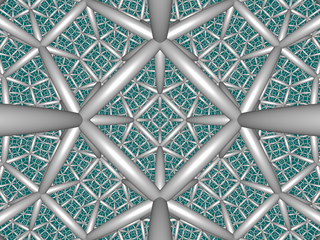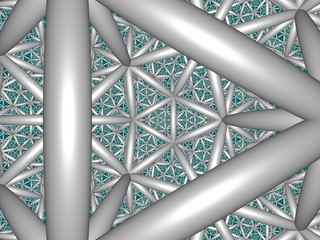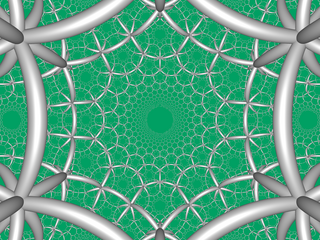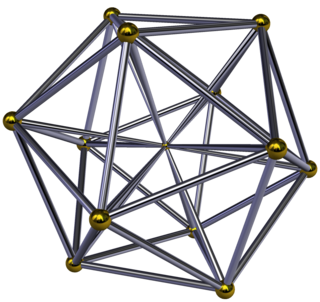In geometry, a dodecahedron or duodecahedron is any polyhedron with twelve flat faces. The most familiar dodecahedron is the regular dodecahedron with regular pentagons as faces, which is a Platonic solid. There are also three regular star dodecahedra, which are constructed as stellations of the convex form. All of these have icosahedral symmetry, order 120.

In geometry, the regular icosahedron is a convex polyhedron that can be constructed from pentagonal antiprism by attaching two pentagonal pyramids with regular faces to each of its pentagonal faces, or by putting points onto the cube. The resulting polyhedron has 20 equilateral triangles as its faces, 30 edges, and 12 vertices. It is an example of the Platonic solid and of the deltahedron. The icosahedral graph represents the skeleton of a regular icosahedron.

In geometry, the snub dodecahedron, or snub icosidodecahedron, is an Archimedean solid, one of thirteen convex isogonal nonprismatic solids constructed by two or more types of regular polygon faces.

In geometry, the truncated dodecahedron is an Archimedean solid. It has 12 regular decagonal faces, 20 regular triangular faces, 60 vertices and 90 edges.

In geometry, the Schläfli symbol is a notation of the form that defines regular polytopes and tessellations.

In hyperbolic geometry, the order-5 cubic honeycomb is one of four compact regular space-filling tessellations in hyperbolic 3-space. With Schläfli symbol {4,3,5}, it has five cubes {4,3} around each edge, and 20 cubes around each vertex. It is dual with the order-4 dodecahedral honeycomb.

In geometry, the icosahedral honeycomb is one of four compact, regular, space-filling tessellations in hyperbolic 3-space. With Schläfli symbol {3,5,3}, there are three icosahedra around each edge, and 12 icosahedra around each vertex, in a regular dodecahedral vertex figure.

A regular dodecahedron or pentagonal dodecahedron is a dodecahedron that is regular, which is composed of 12 regular pentagonal faces, three meeting at each vertex. It is one of the five Platonic solids. It has 12 faces, 20 vertices, 30 edges, and 160 diagonals. It is represented by the Schläfli symbol {5,3}.

In geometry, the excavated dodecahedron is a star polyhedron that looks like a dodecahedron with concave pentagonal pyramids in place of its faces. Its exterior surface represents the Ef1g1 stellation of the icosahedron. It appears in Magnus Wenninger's book Polyhedron Models as model 28, the third stellation of icosahedron.
In geometry, a pentagonal polytope is a regular polytope in n dimensions constructed from the Hn Coxeter group. The family was named by H. S. M. Coxeter, because the two-dimensional pentagonal polytope is a pentagon. It can be named by its Schläfli symbol as {5, 3n − 2} (dodecahedral) or {3n − 2, 5} (icosahedral).

In 4-dimensional geometry, the dodecahedral pyramid is bounded by one dodecahedron on the base and 12 pentagonal pyramid cells which meet at the apex. Since a dodecahedron's circumradius is greater than its edge length, the pentagonal pyramids require tall isosceles triangle faces.

In the field of hyperbolic geometry, the order-5 hexagonal tiling honeycomb arises as one of 11 regular paracompact honeycombs in 3-dimensional hyperbolic space. It is paracompact because it has cells composed of an infinite number of faces. Each cell consists of a hexagonal tiling whose vertices lie on a horosphere, a flat plane in hyperbolic space that approaches a single ideal point at infinity.

In the geometry of hyperbolic 3-space, the dodecahedral-icosahedral honeycomb is a uniform honeycomb, constructed from dodecahedron, icosahedron, and icosidodecahedron cells, in a rhombicosidodecahedron vertex figure.

The icosahedral pyramid is a four-dimensional convex polytope, bounded by one icosahedron as its base and by 20 triangular pyramid cells which meet at its apex. Since an icosahedron's circumradius is less than its edge length, the tetrahedral pyramids can be made with regular faces.

In geometry, an icosahedron is a polyhedron with 20 faces. The name comes from Ancient Greek εἴκοσι (eíkosi) 'twenty', and ἕδρα (hédra) 'seat'. The plural can be either "icosahedra" or "icosahedrons".

In 4-dimensional geometry, the tetrahedral bipyramid is the direct sum of a tetrahedron and a segment, {3,3} + { }. Each face of a central tetrahedron is attached with two tetrahedra, creating 8 tetrahedral cells, 16 triangular faces, 14 edges, and 6 vertices. A tetrahedral bipyramid can be seen as two tetrahedral pyramids augmented together at their base.

In 4-dimensional geometry, the icosahedral bipyramid is the direct sum of a icosahedron and a segment, {3,5} + { }. Each face of a central icosahedron is attached with two tetrahedra, creating 40 tetrahedral cells, 80 triangular faces, 54 edges, and 14 vertices. An icosahedral bipyramid can be seen as two icosahedral pyramids augmented together at their bases.

In 4-dimensional geometry, the cubical bipyramid is the direct sum of a cube and a segment, {4,3} + { }. Each face of a central cube is attached with two square pyramids, creating 12 square pyramidal cells, 30 triangular faces, 28 edges, and 10 vertices. A cubical bipyramid can be seen as two cubic pyramids augmented together at their base.















